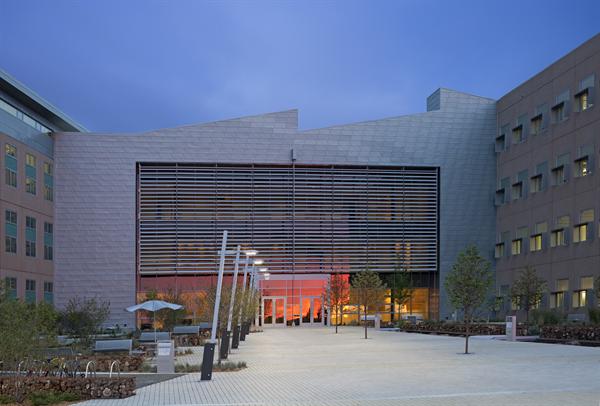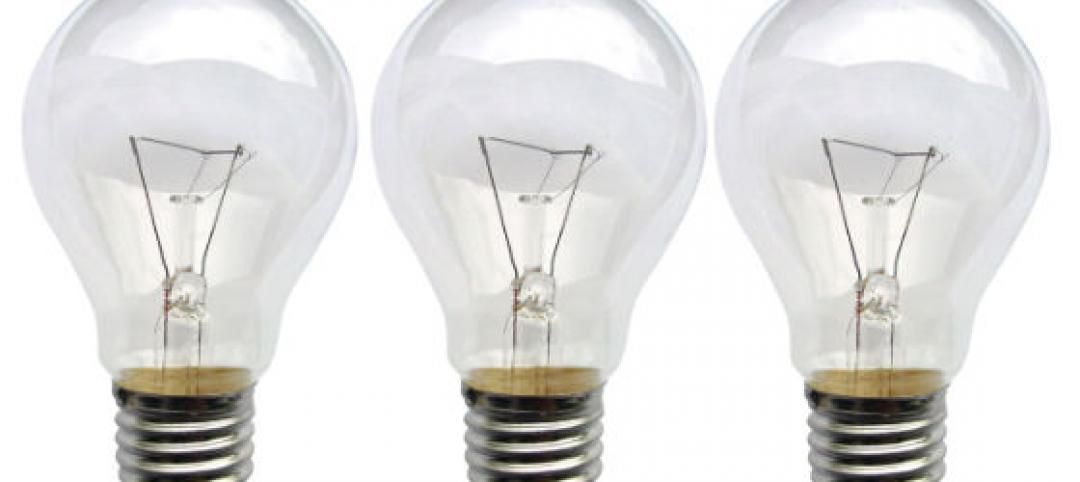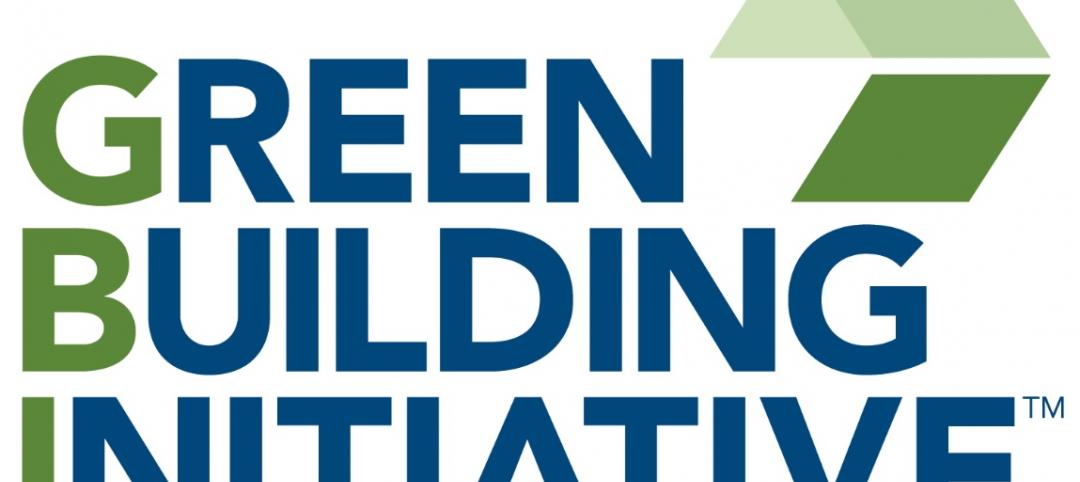The U.S. Department of Energy’s Research Support Facility (RSF), in Golden, Colo., is arguably America’s most significant building of the last decade, at least in terms of energy consumption.
The 220,000-sf, slanted H-shaped office building, on the site of the DOE’s National Renewable Energy Laboratory, produces as much or more energy than it uses—to be specific, 35 kBtu/sf/year, which is 50% below ASHRAE 90.1-2004. The building, which also includes a data center that serves the entire campus, can accommodate 825 staff; it provides 61% more space to the NREL building stock yet adds only 6% in energy demand (which is provided by photovoltaics). Yet it came in at $57.4 million in construction costs, $64 million furnished—or $288/sf complete.
More importantly, the Building Team achieved these remarkable numbers through rigorous energy-conservation methods that brought the RSF’s energy use down by about 80% compared to a conventional building. Only after all energy-saving strategies were applied were renewable energy sources used. In all cases, only readily available, made-in-the-USA technologies and systems were used.
The DOE and NREL held a national design competition to pick the team, setting forth 26 project objectives in a fast-track, multi-bid proposal. Three objectives were deemed “mission critical”: a LEED Platinum rating, Energy Star First “Plus,” and safe work performance. The other 23 were termed “highly desirable”—such as providing room for at least 742 staff—or “if possible,” notably net-zero energy use, “most energy-efficient building in the world,” and a LEED Platinum “Plus” rating. Moreover, the project had to demonstrate that a “distinctively new class of real estate” was feasible and replicable by the private sector.
The winning team, led by design firm RNL and GC Haselden Construction (with engineering from Stantec Consulting), vowed to meet or exceed all 26 objectives. This was risky, since the team would be paid only 50% of the cost of completing the preliminary design; if the DOE didn’t like it, the feds could terminate the contract with no additional payment.
The Building Team evaluated and tested a multitude of technologies before choosing the systems that would go into the structure. These included hydronic radiant slab heating and cooling employing 45 miles of piping; a below-grade maze of heavy concrete structures to store thermal energy for passive cooling and heating; a dedicated outside air system that provides fresh air via raised floors when the windows are closed; and a thermally massive exterior wall system using insulated precast tilt-up panels.
Modular workstations, raised floor systems, and demountable walls were tested via full-scale mockups to provide optimal daylighting, thermal comfort and control, sound control, and indoor air quality. Occupied spaces are no more than 30 feet from an operable window. A mechanical system opens the windows on cool summer nights.
Working intensively with subcontractors, the team installed a standing seam metal roof 90 days ahead of schedule so that photovoltaics could be installed on time. Two of the technologies used in the RSF—transpired solar collectors and electrochromic windows—were co-developed by NREL scientists. Nearly 600 windows were placed, many of them crowned with specially designed “bonnets” to control interior heat buildup (see http://www.bdcnetwork.com/article/windows-keep-green-goals-view).
As impressive as the technological innovations were, the real breakthrough had to do with the team’s embrace of the DOE performance-based procurement process. In a radical departure from standard DOE procedures, the Building Team negotiated with DOE over a two-month period to redefine standard construction contracts, federal acquisition regulations, and RFP contract terms.
The final contract contained more than a dozen specially crafted clauses, and the new contracting method—performance-based design-build—proved so successful that it has become the new NREL model for subsequent high-performance DOE construction projects, including a new building at NREL that Haselden and RNL are working on. In fact, the team’s performance was rated “superior” on each of the 26 objectives, qualifying them for $2 million in contract incentives.
“This would have to be one of the most collaborative projects I’ve seen in recent years,” said juror Michael Damore, Executive Managing Director of A/E firm Epstein, Chicago. Said J.A. Detamore, PhD, PE, PMP, Director, NREL Infrastructure and Campus Development, “The level of innovation and creativity that went into this [project] is simply outstanding. The project represents the highest level of partnering I have ever been part of in my 29 years of experience.”
The lesson of the NREL Research Support Facility is clear: If the U.S. government can build a net-zero energy office building at market-rate cost, why can’t the private sector do so?
Related Stories
| Jan 23, 2014
Adrian Smith + Gordon Gill-designed Federation of Korean Industries tower opens in Seoul [slideshow]
The 50-story tower features a unique, angled building-integrated photovoltaic (BIPV) exterior designed to maximize the amount of energy collected.
| Jan 16, 2014
The incandescent light bulb is not dead
Despite misleading media reports, January 1 did not mark a ban on the manufacture or import of 60-watt and 40-watt incandescent bulbs.
| Jan 11, 2014
Getting to net-zero energy with brick masonry construction [AIA course]
When targeting net-zero energy performance, AEC professionals are advised to tackle energy demand first. This AIA course covers brick masonry's role in reducing energy consumption in buildings.
| Jan 6, 2014
Green Building Initiative names Jerry Yudelson as new President
The Green Building Initiative announced today that it has named Jerry Yudelson as its president to accelerate growth of the non-profit and further leverage its green building assessment tools, including the highly recognized Green Globes rating system.
| Jan 6, 2014
An interview with Jerry Yudelson, President, The Green Building Initiative
Green building consultant Jerry Yudelson has been named President of the Green Building Initiative and the Green Globes rating program. BD+C's Robert Cassidy talks with Yudelson about his appointment and the future of Green Globes.
| Jan 2, 2014
Measuring whole building energy use among big changes in LEED v4
A new prerequisite in LEED v4 calls for each project to measure whole building energy use, and then share that data with USGBC.
| Dec 31, 2013
Top 10 blog posts from 2013
BD+C editors and our contributors posted hundreds of blogs in 2013. Here's a recap of the most popular topics. They include valuable lessons from one of the first BIM-related lawsuits and sage advice from AEC legend Arthur Gensler.
| Dec 20, 2013
Can energy hogs still be considered efficient buildings? Yes, say engineers at Buro Happold
A new tool from the engineering firm Buro Happold takes into account both energy and economic performance of buildings for a true measure of efficiency.
| Dec 17, 2013
Nation's largest net-zero K-12 school among winners of 2013 Best of Green Schools award
The Lady Bird Johnson Middle School in Irving, Texas, was named a winner of USGBC's annual award, along with nine other schools, individuals and communities working toward the common goal of healthy, high-performing learning places.
| Dec 10, 2013
16 great solutions for architects, engineers, and contractors
From a crowd-funded smart shovel to a why-didn’t-someone-do-this-sooner scheme for managing traffic in public restrooms, these ideas are noteworthy for creative problem-solving. Here are some of the most intriguing innovations the BD+C community has brought to our attention this year.

















